Jinas
Veneration of the 24 Jinas is the most significant devotional focus in Jainism. These perfected-beings serve as role models to guide the faithful on the proper path to liberation from the endless cycles of rebirth. While all are revered as great teachers, four of the Jinas occupy the most exalted positions and have received particular attention in textual and artistic portrayals.
The most recent Jina is Mahavira (about 599-527 BC), a contemporary of the Buddha, who was instrumental in fostering the Jain faith as a reaction against the established caste system and its associated sacrificial rituals.
The conceptual basis for the image of a Jina is the pan-Indian ideal of the yogic or ascetic wanderer. Jinas are always shown in the seated posture or the standing body-abandonment pose (kayotsarga). The latter is position uniquely Jain and combines vigorous austerity and non-violence through immobility, thereby avoiding even accidental injury to other creatures. Perhaps because Jain images are often indistinguishable from those of the Buddha, a distinctive chest mark (srivatsa) was introduced to establish a deity's identity as a Jina.
Early in their history, due in part to a conflict over what constitutes total renunciation, Jainism split into two groups: the Svetambaras (meaning 'white clad' or clothed) and the Digambaras ('sky clad' or naked).
The Digambaras are the more austere sect and their monks consider any possessions, including clothing, a hindrance to spiritual liberation.
Other Jain deities
While the Jinas are the highest venerated members of the Jain pantheon, there are many other deities and subsidiary divinities portrayed in Jain art. These include gods and goddesses, guardian spirits and celestial beings who, it is assumed, came to be worshipped as a result of exchanges of ideas with Hinduism and Buddhism. All India's early religions shared a common ancestry in the nature cults of the ancient Vedic period.
While many of the secondary members of the Jain pantheon are shared with the Hindus and Buddhists, Jain artistic representations generally emphasise only their benign forms, due to the principle of non-violence.
Figures:
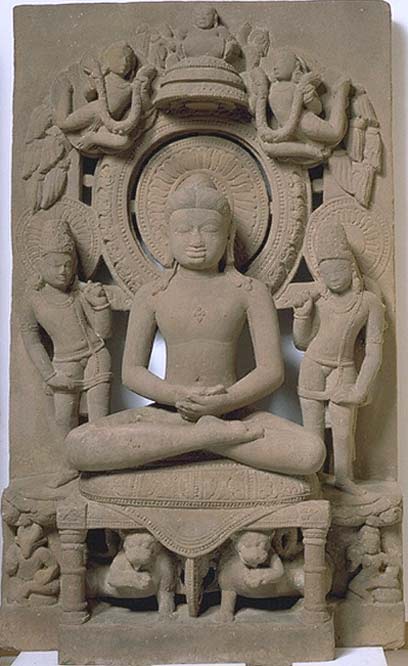 |
Rishabhanatha, Uttar Pradesh, India. 9th century. Sandstone sculpture. Museum no. IS.12-1996 |
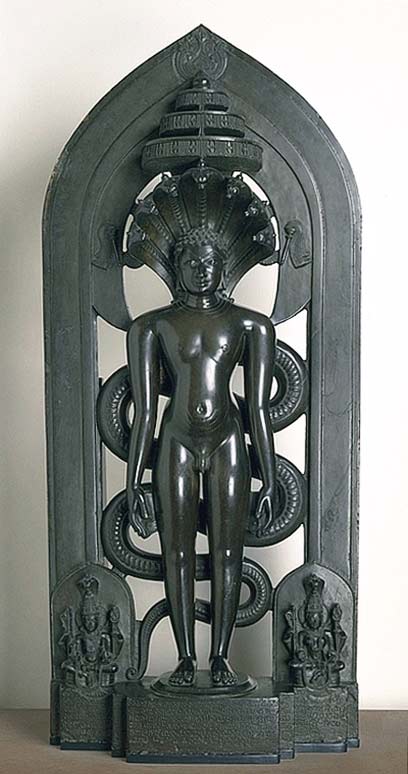 |
Parsvanatha with seven-hooded cobra canopy, standing in kayotsarga pose, Chakravarti Paloja, Gulbarga, Southern India, 12th century. Black shale sculpture. Museum no. 931(IS) |
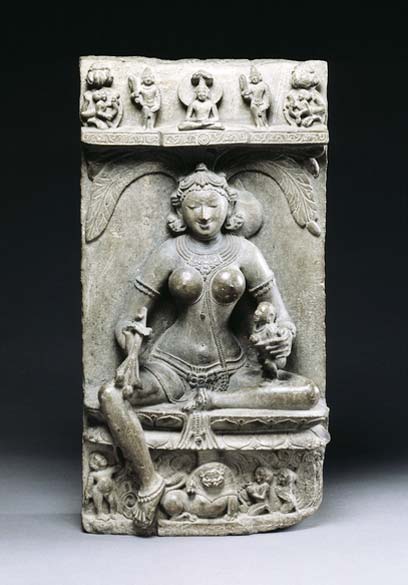 |  |
a. Goddess Ambika | b. Gamdharva |
a. Goddess Ambika, Orissa, eastern India, 12th century, Grey chlorite Museum no. IS.61-1963. The most popular of all the yakshis is Ambika, who is venerated for her powers of fertility and maternity. | |
| b. Celestial Drummer (Gandharva), Halebid, Karnataka, 13th century, Potstone, Musuem no. IM.302-1920. The largest group within the Jain pantheon (after the deities that also worshipped by Hindus and the yakshas and yakshis nature spirits), consists of celestial beings such as the goddesses of magical powers (vidyadevis), who preside over esoteric rites and number as many as 48,000; heavenly musicians (gandharvas), as shown here, who attend and extol the Jinas and divine attendants serving as honorific flywhisk bearers. | |
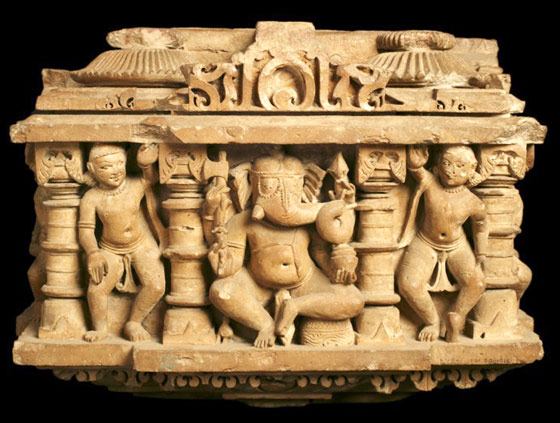 |
Relief depicting Ganesa |
Palitana, gujarat, western India
Other popular deities who are also worshipped by Hindus include Sri Laksmi, the goddess of good fortune and prosperity, and Ganesa, the elephant-headed god who helps to overcome obstacles. He is worshipped at the beginning of undertakings such as a journey, a business venture or a period of study. |
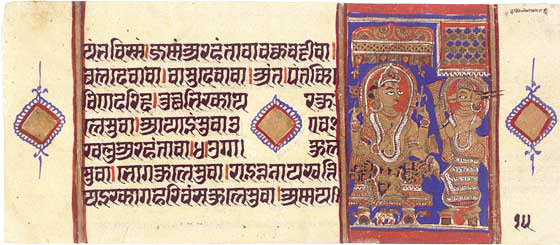 |
Kalpasutra manuscript |
Western India, 16th century
Page from a Kalpasutra manuscript depicting Indra ordering Harinegamesin to exchange the embryo of Mahavira from Devananda's womb to Trishala's. The chief of the earliest Indian gods, Indra (also known as Sakra in many Jain texts), figures prominently in the lives of the Jinas. |
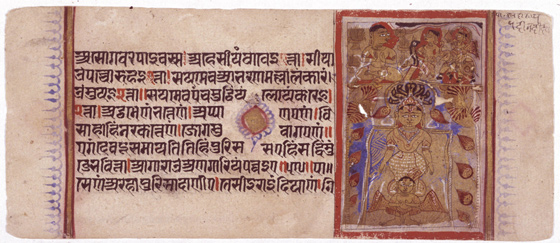 |
Kalpasutra manuscript |
Gujarat, western India
Page from a Kalpasutra manuscript depicting Parsvanatha on an elephant releasing Dharanendra from fire penance (above) and (below) Dharanendra sheltering Parsvanatha. Male and female nature spirits (yakshas and yakshis) are depicted in Jain art as guardian spirits who attend the Jinas. They are sometimes the focus of independent cults among the laity. Dharanendra is unique among the Jain yakshas because of his crucial role in sheltering the Jina Parsvanatha during his penance. As well as being considered a yaksha, Dharanendra is also a naga or serpent-king, and is often depicted as a multi-headed snake. |
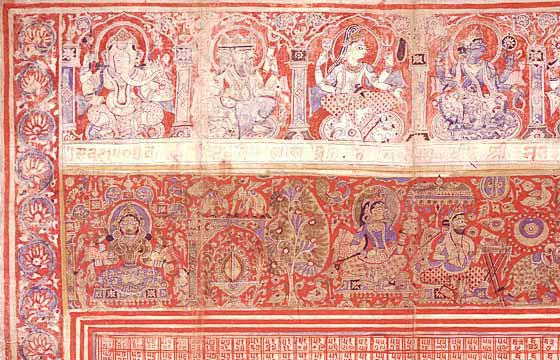 |
Detail of Victory Banner |
1447 CE
Detail of Victory Banner (Jayantra Yantra) showing the gods Ganesha, Brahma, Siva, Visnu and Sarasvati (upper register). The Hindu and Buddhist goddess of knowledge, Sarasvati, was incorporated into the Jain pantheon at a very early date. She remains one of the most important goddesses, due no doubt to the Jains' belief in the central role of knowledge in gaining the profound wisdom necessary to break the cycle of rebirth. |
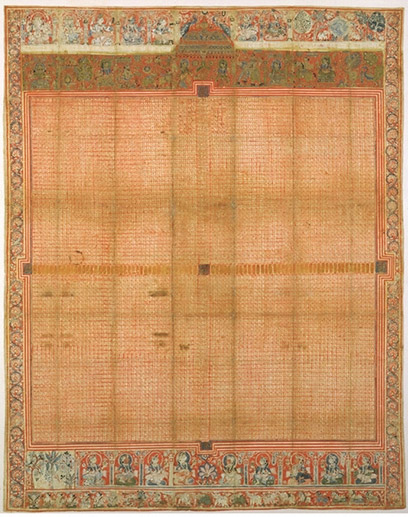 |
Victory Banner |
1447 CE
Nine planetary deities from a Victory Banner, (lowest register). Planetary deities, such as the ones shown here at the bottom of the banner, are also venerated. |
